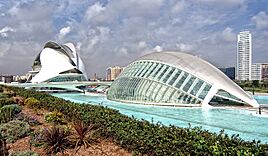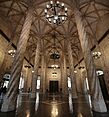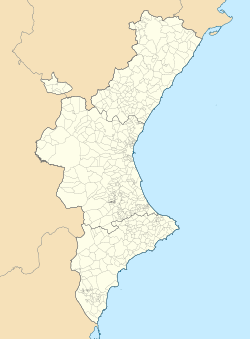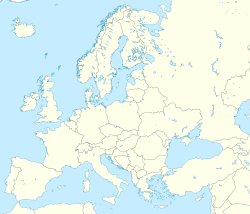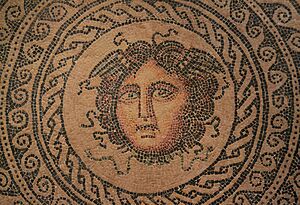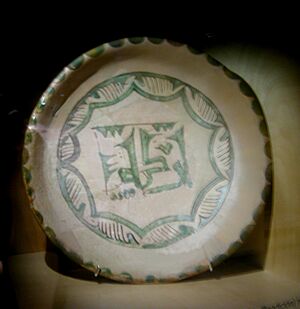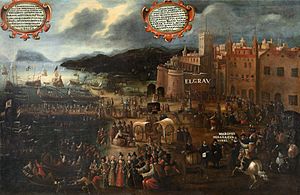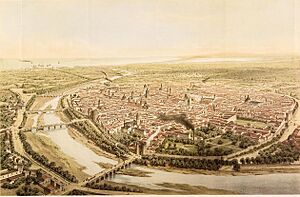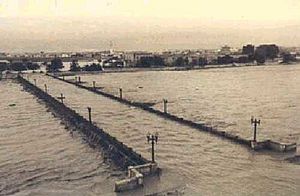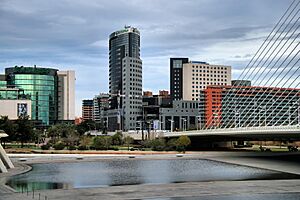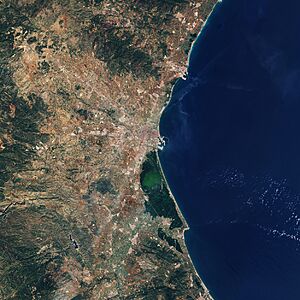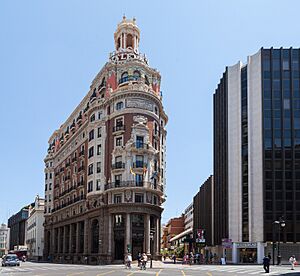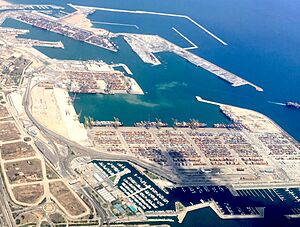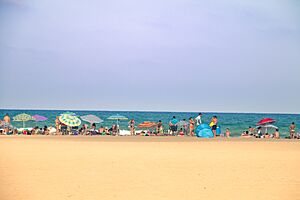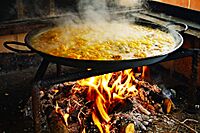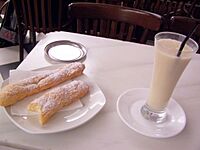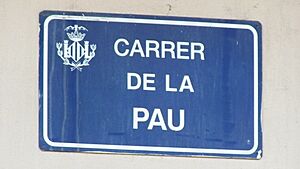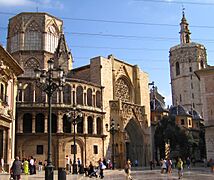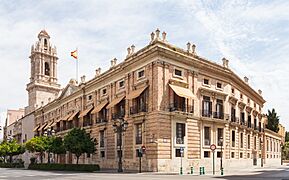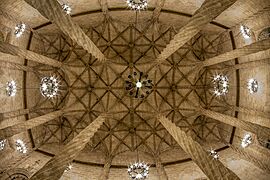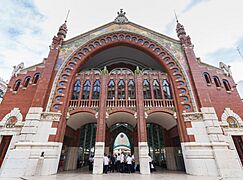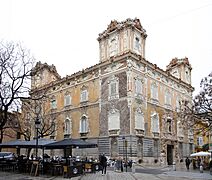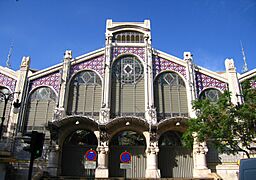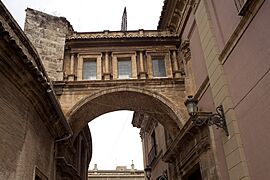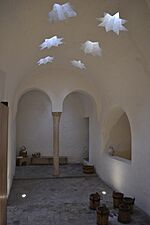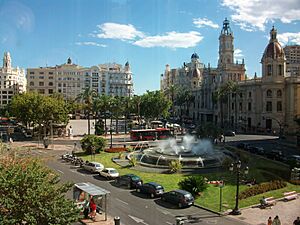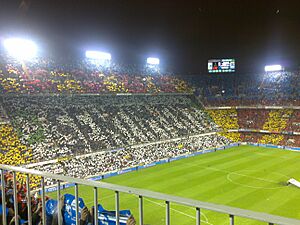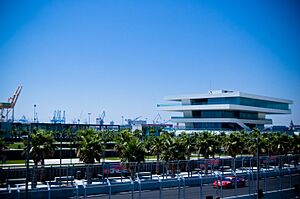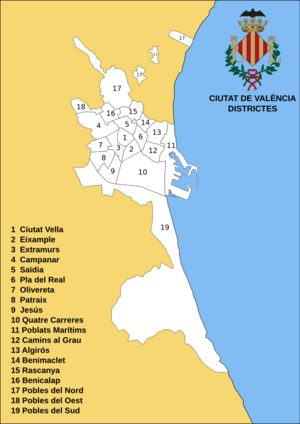Valencia facts for kids
Quick facts for kids
Valencia
|
|||
|---|---|---|---|
| València (official) | |||
|
|
|||
|
|||
| Country | |||
| Autonomous community | |||
| Province | |||
| Comarca | Horta of Valencia | ||
| Founded | 138 BC | ||
| Districts |
19 districtes
Ciutat Vella
Eixample Extramurs Campanar Saïdia Pla del Real Olivereta Patraix Jesús Quatre Carreres Poblats Marítims Camins al Grau Algirós Benimaclet Rascanya Benicalap Pobles del Nord Pobles de l'Oest Pobles del Sud |
||
| Government | |||
| • Type | Ajuntament | ||
| • Body | Ajuntament de València | ||
| Area | |||
| • Municipality | 134.65 km2 (51.99 sq mi) | ||
| • Urban | 628.81 km2 (242.78 sq mi) | ||
| Elevation | 15 m (49 ft) | ||
| Population
(2023)
|
|||
| • Municipality | 807,693 | ||
| • Density | 5,998.5/km2 (15,536/sq mi) | ||
| • Urban | 1,595,000 | ||
| • Metro | 2,522,383 | ||
| Demonym(s) | Valencian • valencià, -ana (va) • valenciano, -na (es) |
||
| GDP | |||
| • Metro | €56.413 billion (2020) | ||
| Time zone | UTC+01:00 (CET (GMT)) | ||
| • Summer (DST) | UTC+02:00 (CEST (GMT)) | ||
| Postcode |
46000-46080
|
||
| ISO 3166-2 | ES-V | ||
| Website | www.valencia.es | ||
Valencia is a vibrant city in Spain. It is the capital of the province and the region with the same name. With over 800,000 people, it is the third-largest city in Spain. Valencia is located on the east coast of the Iberian Peninsula, right by the Mediterranean Sea. The Turia River flows through the city.
Valencia started as a Roman settlement in 138 BC. It was called Valentia Edetanorum. Over centuries, it was ruled by different groups, including the Visigothic Kingdom and later Islamic rulers. In 1238, the Aragonese Christians took control. The city became the capital of the Kingdom of Valencia. The 15th century was a "Golden Age" for Valencia. It became a major trading hub in Europe.
The Port of Valencia is one of the busiest in Europe. It is a very important port for trade in the Mediterranean Sea. Valencia is known as a "Gamma-level global city". This means it is an important city in the world. Its old town is one of the largest in Spain. Valencia has many exciting traditions. One of the most famous is the Falles festival. UNESCO recognized it as an important cultural heritage in 2016. In recent years, Valencia has been named the world's top city for people moving abroad. It was also the European Capital of Sport in 2011 and the European Green Capital in 2024.
Contents
What's in a Name?

The city's original Latin name was Valentia. This means "strength" or "bravery". The Romans gave it this name to honor their soldiers. These soldiers had fought bravely against a rebel leader named Viriatus.
During the time of Islamic rule, the city was called Medina at-Tarab. This means 'City of Joy'. Some also called it Medina at-Turab, or 'City of Sands'. This was because it was built near the Turia River. The Arabic name Balansiyya might have been used for the wider area.
Over time, Valentia changed. It became Valencia in Spanish. In Valencian, it is called València. The name "València" has been the only official name since 2017.
A Look Back: Valencia's History
Early Beginnings: Roman Times
Valencia is one of Spain's oldest cities. It was founded by the Romans around 138 BC. They named it Valentia Edetanorum. After the Western Roman Empire fell, the Catholic Church took over. Germanic groups like the Visigoths also came to the city.
Medieval Valencia: From Moors to Christians
Valencia became part of the Visigothic Kingdom from 546 to 711 AD. Around 714 AD, the city surrendered to the Moors. The Moors introduced new ways of farming and new crops. Valencia was then known as Madînat al-Turâb, or 'city of earth'.
Later, Valencia became an independent emirate. This was called the Taifa of Valencia. The city grew a lot during this time. Many Jewish people lived here, including the famous poet Solomon ibn Gabirol.
In 1094, a famous warrior called "El Cid" took control of Valencia. He set up his own kingdom. After he left, the Almoravids took over.
In 1238, King James I of Aragon conquered Valencia. His army included people from Aragon and Catalonia. About 50,000 Moors had to leave the city.
The 14th century was tough for Valencia. The Black Death caused many deaths. There were also wars and riots. In 1391, the Jewish quarter was destroyed.
By the late 1300s, traders from Genoa helped Valencia. They brought in new ways to make silk. Valencia became a major center for silk production.
In 1407, Valencia created a public bank. This helped the city's economy.
The 15th century was a "Golden Age" for Valencia. The economy grew, and arts and culture thrived. Valencia became the biggest city in the Crown of Aragon. Famous buildings like the Serranos Towers and the Silk Exchange were built then. Valencia also became a big center for the slave trade.
Modern Times: Changes and Challenges
After 1516, there were conflicts in Valencia. A civil war, called the Revolt of the Brotherhoods, happened from 1521 to 1522. In 1526, Muslim people were forced to convert to Christianity.
During the 16th century, pirates from North Africa attacked the coast. This made the area unsafe. It also hurt Valencia's trade. The city's economy suffered.
The 17th century brought more problems. In 1609, the Moriscos were expelled. These were descendants of Muslims who had converted to Christianity. Their expulsion caused financial ruin for many nobles.
The War of the Spanish Succession (1702–1709) ended Valencia's political independence. Valencia supported Charles of Austria. After the Bourbons won, King Philip V removed Valencia's old laws. The city was then governed by Castilian laws.
In the 18th century, Valencia's economy recovered. Silk manufacturing and ceramic tiles became important. Valencia became Spain's main silk-making center.
Wars and Revolutions
The 19th century started with wars. The Peninsular War (1808-1814) greatly affected Valencia. Napoleon's armies invaded Spain. The people of Valencia fought back.
French Marshal Suchet besieged the city in 1811. Valencia surrendered in 1812. For a short time, Valencia became the capital of Spain. The French troops left in 1813.
After the war, Ferdinand VII became king. He brought back absolute rule. The city experienced political unrest.
The reign of Isabella II (1843–1868) brought stability. Valencia grew and prospered. Landowners became rich from orange crops and vineyards. Local traditions and the Valencian language also saw a revival.
In 1865, work began to tear down the old city walls. This opened up the city for more growth.
Valencia in the 20th Century
In the early 1900s, Valencia was an industrial city. It produced leather, wood, metals, and food. The city also had beautiful Art Nouveau buildings. These included the North Station and the Central Market.
World War I (1914–1918) hurt Valencia's economy. The Second Spanish Republic (1931–1939) brought more democracy.
During the Spanish Civil War, Valencia became the temporary capital of Republican Spain. This was from November 1936 to October 1937. The city was heavily bombed during the war. Many people died.
After the War
The years after the war were difficult. Speaking Valencian was forbidden under Franco's rule. Many intellectuals were executed or forced into exile.
In 1957, a major flood from the Turia River hit Valencia. This caused many deaths and much damage. The river was then diverted to a new bed. The old riverbed became a beautiful park. The economy started to recover in the 1960s. The city grew quickly as people moved there for jobs.
Valencia Today: A Modern City
With Spain's return to democracy, Valencia became the capital of the Valencian Community. The city has grown culturally. New buildings like the City of Arts and Sciences were built. These projects have made Valencia a great place to live and visit. Tourism has also increased.
Valencia in the 21st Century
In 2006, a metro accident in Valencia caused many deaths. Days later, Pope Benedict XVI visited the city. He used the Sant Calze, which some believe is the Holy Grail.
Valencia hosted the famous America's Cup yacht race in 2007 and 2009. This was the first time a European city hosted it. These events brought many visitors to Valencia.
From 1991 to 2015, Rita Barberá was the mayor. After the 2015 election, Joan Ribó became the new mayor.
Where is Valencia?
Location and Landscape
Valencia is on the eastern coast of Spain. It faces the Gulf of Valencia in the Mediterranean Sea. The city is built on fertile land near the Turia River. When the Romans founded it, it was a few kilometers from the sea.
The Albufera lagoon is about 12 km south of the city. It used to be saltwater. Now it is a freshwater lagoon. The area around the lagoon is used for growing rice. It is also a place for hunting and fishing.
The Valencia City Council bought the lake in 1911. Today, it is part of the Parc Natural de l'Albufera. This is a nature reserve. It is important for its culture, history, and nature.
Valencia's Climate
Valencia has a Mediterranean climate. This means it has mild winters and hot, dry summers. The average temperature is about 18.6°C. In winter, temperatures are around 15-20°C during the day. In summer, they are usually 28-32°C.
It can feel very humid in summer. This makes the heat feel stronger. Snowfall is very rare in Valencia. The last time snow covered the ground was in 1960. Valencia has one of the mildest winters in Europe.
The city gets about 2,670 hours of sunshine each year. The sea temperature is about 14-15°C in winter and 25-26°C in summer.
| Climate data for Valencia (normals and extremes 1991-2020), altitude: 11 m.a.s.l. | |||||||||||||
|---|---|---|---|---|---|---|---|---|---|---|---|---|---|
| Month | Jan | Feb | Mar | Apr | May | Jun | Jul | Aug | Sep | Oct | Nov | Dec | Year |
| Record high °C (°F) | 26.6 (79.9) |
27.2 (81.0) |
31.0 (87.8) |
33.4 (92.1) |
42.0 (107.6) |
38.2 (100.8) |
40.3 (104.5) |
43.0 (109.4) |
38.4 (101.1) |
35.8 (96.4) |
31.2 (88.2) |
26.8 (80.2) |
43.0 (109.4) |
| Mean daily maximum °C (°F) | 16.7 (62.1) |
17.4 (63.3) |
19.3 (66.7) |
21.1 (70.0) |
23.9 (75.0) |
27.3 (81.1) |
29.7 (85.5) |
30.3 (86.5) |
27.8 (82.0) |
24.5 (76.1) |
20.1 (68.2) |
17.3 (63.1) |
23.0 (73.3) |
| Daily mean °C (°F) | 12.2 (54.0) |
12.8 (55.0) |
14.7 (58.5) |
16.6 (61.9) |
19.5 (67.1) |
23.1 (73.6) |
25.7 (78.3) |
26.2 (79.2) |
23.5 (74.3) |
20.0 (68.0) |
15.6 (60.1) |
12.9 (55.2) |
18.6 (65.4) |
| Mean daily minimum °C (°F) | 7.7 (45.9) |
8.2 (46.8) |
10.0 (50.0) |
12.0 (53.6) |
15.1 (59.2) |
18.8 (65.8) |
21.7 (71.1) |
22.2 (72.0) |
19.2 (66.6) |
15.6 (60.1) |
11.1 (52.0) |
8.5 (47.3) |
14.2 (57.5) |
| Record low °C (°F) | −1.6 (29.1) |
−0.5 (31.1) |
1.2 (34.2) |
5.0 (41.0) |
6.0 (42.8) |
12.6 (54.7) |
16.0 (60.8) |
16.2 (61.2) |
11.6 (52.9) |
6.3 (43.3) |
2.4 (36.3) |
−0.3 (31.5) |
−1.6 (29.1) |
| Average precipitation mm (inches) | 38.6 (1.52) |
29.8 (1.17) |
39.5 (1.56) |
32.7 (1.29) |
36.2 (1.43) |
26.3 (1.04) |
6.7 (0.26) |
14.7 (0.58) |
72.2 (2.84) |
63.4 (2.50) |
51.6 (2.03) |
46.2 (1.82) |
457.9 (18.04) |
| Average precipitation days (≥ 1mm) | 4.1 | 3.5 | 4.1 | 4.5 | 4.2 | 2.2 | 1.2 | 2.3 | 5.2 | 4.7 | 4.3 | 4.3 | 44.6 |
| Mean monthly sunshine hours | 168.0 | 174.2 | 210.5 | 232.7 | 260.2 | 276.7 | 307.6 | 282.6 | 231.4 | 201.2 | 166.2 | 151.8 | 2,663.1 |
| Source: NOAA/NCEI | |||||||||||||
| Climate data for Valencia (4 km [2 mi] from sea, altitude: 11 m.a.s.l., averages 1981–2010) | |||||||||||||
|---|---|---|---|---|---|---|---|---|---|---|---|---|---|
| Month | Jan | Feb | Mar | Apr | May | Jun | Jul | Aug | Sep | Oct | Nov | Dec | Year |
| Mean daily maximum °C (°F) | 16.4 (61.5) |
17.1 (62.8) |
19.3 (66.7) |
20.8 (69.4) |
23.4 (74.1) |
27.1 (80.8) |
29.7 (85.5) |
30.2 (86.4) |
27.9 (82.2) |
24.3 (75.7) |
19.8 (67.6) |
17.0 (62.6) |
22.8 (73.0) |
| Daily mean °C (°F) | 11.9 (53.4) |
12.7 (54.9) |
14.6 (58.3) |
16.2 (61.2) |
19.0 (66.2) |
22.9 (73.2) |
25.6 (78.1) |
26.1 (79.0) |
23.5 (74.3) |
19.7 (67.5) |
15.3 (59.5) |
12.6 (54.7) |
18.3 (64.9) |
| Mean daily minimum °C (°F) | 7.1 (44.8) |
7.8 (46.0) |
9.7 (49.5) |
11.5 (52.7) |
14.6 (58.3) |
18.6 (65.5) |
21.5 (70.7) |
21.9 (71.4) |
19.1 (66.4) |
15.2 (59.4) |
10.8 (51.4) |
8.1 (46.6) |
13.8 (56.8) |
| Average precipitation mm (inches) | 37 (1.5) |
36 (1.4) |
33 (1.3) |
38 (1.5) |
39 (1.5) |
22 (0.9) |
8 (0.3) |
20 (0.8) |
70 (2.8) |
77 (3.0) |
47 (1.9) |
48 (1.9) |
475 (18.7) |
| Average precipitation days (≥ 1 mm) | 4.4 | 3.9 | 3.6 | 4.8 | 4.3 | 2.6 | 1.1 | 2.4 | 5.0 | 5.0 | 4.3 | 4.8 | 46.3 |
| Average relative humidity (%) | 64 | 64 | 63 | 62 | 65 | 66 | 67 | 68 | 67 | 67 | 66 | 65 | 65 |
| Mean monthly sunshine hours | 171 | 171 | 215 | 234 | 259 | 276 | 315 | 288 | 235 | 202 | 167 | 155 | 2,696 |
| Source: Agencia Estatal de Meteorología | |||||||||||||
People of Valencia
| Historical population | ||
|---|---|---|
| Year | Pop. | ±% |
| 1842 | 66,355 | — |
| 1857 | 106,435 | +60.4% |
| 1860 | 107,703 | +1.2% |
| 1877 | 142,063 | +31.9% |
| 1887 | 168,740 | +18.8% |
| 1897 | 203,958 | +20.9% |
| 1900 | 215,687 | +5.8% |
| 1910 | 233,018 | +8.0% |
| 1920 | 247,281 | +6.1% |
| 1930 | 315,816 | +27.7% |
| 1940 | 454,654 | +44.0% |
| 1950 | 503,886 | +10.8% |
| 1960 | 501,777 | −0.4% |
| 1970 | 648,003 | +29.1% |
| 1981 | 744,748 | +14.9% |
| 1991 | 752,909 | +1.1% |
| 2001 | 738,441 | −1.9% |
| 2011 | 792,054 | +7.3% |
| 2021 | 788,842 | −0.4% |
| Source: National Statistics Institute | ||
Valencia is the third-largest city in Spain. It is also the 24th most populated city in the European Union. In 2009, about 809,267 people lived within its city limits. The larger metropolitan area has over 1.5 million people.
From 2001 to 2011, Valencia's population grew by 14.1%. Many people moved to Valencia from other countries. The largest groups came from Bolivia, Romania, and Italy.
Valencia's Economy
Valencia's economy grew a lot before 2008. This growth was mainly due to tourism and construction. Telecommunications and transport also expanded. Most people in Valencia work in the service industry. This includes jobs like tourism, retail, and healthcare.
However, Valencia still has important factories. About 8.5% of people work in manufacturing. Car assembly is a big part of this. The Ford factory in Almussafes is a major employer. Farming is still done, but it is a small part of the economy. Farmers mostly grow oranges and other citrus fruits.
Valencia faced economic challenges after 2008. But it was named the "29th fastest-improving European city" in 2009. Valencia is considered a "Gamma" global city. This means it has a strong influence in business, education, and entertainment.
The city has a stock exchange. This is where shares of companies are bought and sold. The Valencia metropolitan area has a high economic output.
In 2021, the European Investment Bank gave Valencia a loan. This money helps build affordable public housing.
Busy Port of Valencia
Valencia's port is the largest on the western Mediterranean coast. It is the busiest port in Spain for containers. It handles 20% of Spain's exports. The main goods exported are food and drinks. Other exports include oranges, furniture, and textiles.
Valencia's factories make metal products, chemicals, and textiles. They also build ships and brew drinks. Many small and medium-sized businesses are important to the local economy.
The port was changed a lot for the America's Cup yacht race in 2007. It was divided into two parts. One part was for the race events.
Getting Around Valencia
Valencia has good public transport. Ferrocarrils de la Generalitat Valenciana (FGV) runs the Metrovalencia system. This includes trains and trams. The North Station is the main train station. A newer station, Estació de València-Joaquín Sorolla, handles high-speed trains.
Valencia Airport is about 9 km west of the city center.
Valencia also has a bicycle-sharing system called Valenbisi. It has over 2,750 bikes at 250 stations. People usually spend about 44 minutes on public transport each weekday.
Exploring Valencia: Tourism
Since the mid-1990s, Valencia has become a popular tourist spot. Many old buildings have been restored. These include the medieval Torres de Serranos and Quart Towers. The Passeig Marítim is a 4 km long beach promenade. It runs along the city's beaches.
Valencia has a lively nightlife. There are many bars and nightclubs. The city also has large convention centers for business events.
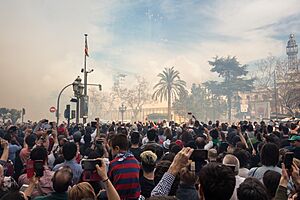
Valencia is famous for its festivals. The Falles is a major festival in March. It is a Celebration of International Tourist Interest. The Water Tribunal of Valencia (Tribunal de les Aigües de València) is another unique tradition. It helps solve problems about irrigation water. UNESCO also recognized it as a cultural heritage.
Valencia has hosted big international events. These include the America's Cup yacht races and Formula One auto racing. The final round of the MotoGP Championship is held nearby.
Valencia's Culture
Valencia is known for its food and festivals. The paella valenciana is a famous rice dish that comes from Valencia. The city is also known for its traditional ceramics and clothing. The unique architecture of the City of Arts and Sciences is also a cultural highlight.
The city has many traditional Catholic festivals. The Holy Week celebrations are very colorful.
Valencia used to host the Formula One European Grand Prix. Now, it hosts the annual Moto GP race. This race is usually the last of the season.
The University of Valencia was founded in 1499. It is one of Spain's oldest universities. It is also one of the top universities in the country. In 2012, Boston's Berklee College of Music opened a campus in Valencia.
Delicious Valencian Food
Valencia is famous for its food. Paella, a rice dish with meat or seafood, was created here. Other traditional dishes include fideuà (a noodle dish) and arròs a banda (rice cooked in fish broth).
Valencia is also the home of orxata. This is a cold drink made from tiger nuts. It is popular in many parts of the world.
Languages Spoken in Valencia
Valencian and Spanish are the official languages. Spanish is the main language spoken in the city. However, Valencian is taught in schools. Street signs often use only Valencian.
Fun Festivals in Valencia
- Falles
The Falles festival is a huge celebration in Valencia. It lasts five days and nights, from March 15 to 19. Before that, starting March 1, there are daily fireworks shows called mascletàes.
The Falles tradition began in the 18th century. Carpenters would burn old wood to celebrate Saint Joseph's Day. Over time, they started dressing up wooden figures. These were the first ninots. Today, neighborhoods compete to create the most impressive figures. These figures often make fun of famous people or current events.
On the night of March 19, all the Falles figures are burned. This event is called "La Cremà".
- Holy Week
The Setmana Santa Marinera, or Holy Week, is another important festival. It is celebrated in Valencia and is known for its colorful traditions.
Must-See Sights in Valencia
Major landmarks include Valencia Cathedral, the Torres de Serrans, and the Lonja de la Seda. The Silk Exchange is a World Heritage Site recognized by UNESCO. The Ciutat de les Arts i les Ciències (City of Arts and Sciences) is a modern cultural complex. It was designed by famous architects Santiago Calatrava and Félix Candela.
The Museu de Belles Arts de València has many paintings from the 14th to 18th centuries. It includes works by famous artists like Velázquez and Goya. The Institut Valencià d'Art Modern (Valencian Institute of Modern Art) shows modern art and photos.
Valencia's Architecture
The old streets of Barrio del Carmen have buildings from Roman and Arab times. The Cathedral was built between the 13th and 15th centuries. It is mostly Valencian Gothic style, but also has Baroque and Romanesque architecture parts. Next to the cathedral is the Gothic Basilica of the Virgin. The 15th-century Serrans and Quart towers were once part of the city wall.
UNESCO recognized the Silk Exchange market (La Llotja de la Seda) as a World Heritage Site. The Central Market (Mercat Central) is one of Europe's largest. It is built in the Valencian Art Nouveau style. The main railway station, Estació Del Nord, is also in this style.
Santiago Calatrava, a famous architect from Valencia, designed the futuristic City of Arts and Sciences. This complex includes an opera house, a science museum, an IMAX cinema, and an oceanographic park. He also designed a bridge in the city. The Palau de la Música de València (Music Palace) is another example of modern architecture.
-
L’Hemisfèric (IMAX Dome cinema) and Palau de les Arts Reina Sofia
-
Assut de l'Or Bridge and L'Àgora behind.
-
Mudéjar (Christian) baths Banys de l'Almirall (1313-1320)
Valencia Cathedral
The Valencia Cathedral is a very old and important church. It stands where a Roman temple might have been. The first stone of the new Gothic building was laid in 1262. The El Miguelete bell tower was added later. It is about 58 meters high.
The cathedral has many beautiful paintings. The main chapel was decorated in the Baroque style. The main entrance was built in the 18th century. Two other doors lead into the church. One is called the Porta dels Apostols (Portal of the Apostles).
The Tribunal de les Aigües (Water Court) meets every Thursday outside the Porta dels Apostols. This court dates back to Moorish times. It helps solve problems about irrigation water.
Historic Churches
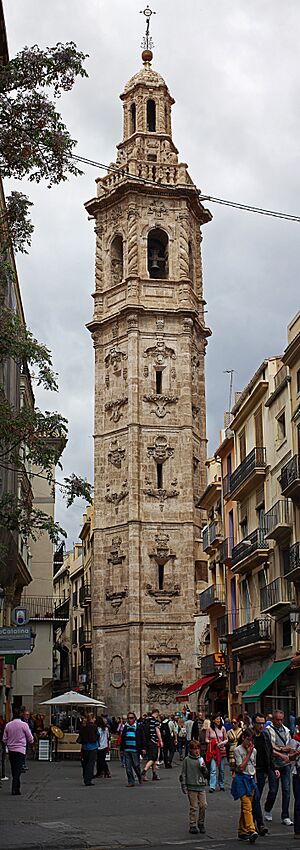
- Sant Joan del Mercat – A Gothic church rebuilt in the Baroque style.
- Sant Nicolau
- Santa Catalina
- Sant Esteve
El Temple was an ancient church of the Knights Templar. The former convent of the Dominicans has a Gothic wing. The Colegio del Corpus Christi is dedicated to the Blessed Sacrament.
Squares and Gardens
The Plaça del Ajuntament is Valencia's largest square. The City Hall and the central post office are here. The square is triangular and has many restaurants. It is a key spot during the Les Falles festival for fireworks.
The Plaça de la Mare de Déu has the Basilica of the Virgin and the Turia fountain. It is popular with both locals and tourists. Nearby is the Plaza de la Reina, with the cathedral and orange trees.
The Turia River was diverted after a flood in 1957. The old riverbed is now the Turia gardens. This park has playgrounds, fountains, and sports fields. The Palau de la Música and the City of Arts and Sciences are next to these gardens. The Valencia Bioparc is a zoo also located in the Turia riverbed.
Other gardens in Valencia include:
- The Jardíns de Monfort
- The Botanical Garden of Valencia
- The Jardins del Real
Museums to Explore

- Ciutat de les Arts i les Ciències (City of Arts and Sciences). This complex was designed by architect Santiago Calatrava. It is built in the old Turia riverbed.
- Palau de les Arts Reina Sofía, an opera and music palace.
- L'Oceanogràfic, the largest aquarium in Europe. It has many ocean animals, including sharks and dolphins.
- El Museu de les Ciències Príncipe Felipe, an interactive science museum. It looks like a whale skeleton.
- L'Hemisfèric, an IMAX cinema.
- Museu de Prehistòria de València (Prehistory Museum)
- Museu Valencià d'Etnologia (Ethnology Museum)
- Institut Valencià d'Art Modern - IVAM (Modern Art Institute)
- Museu de Belles Arts de València (Museum of Fine Arts)
- Museu Faller (Falles Museum)
- Museu d'Història de València (History Museum)
- L'Almoina Museum (Archaeological Center)
- Natural Science Museum of Valencia
- Museu Taurí de València (Bullfighting Museum)
- MuVIM – Museu Valencià de la Il·lustració i la Modernitat (Enlightenment and Modernity Museum)
- González Martí National Museum of Ceramics and Decorative Arts
- Computer Museum, at the Technical University of Valencia
Sports in Valencia
| Club | League | Sport | Venue | Established | Capacity |
|---|---|---|---|---|---|
| Valencia CF | La Liga | Football | Mestalla | 1919 | 49,000 |
| Levante UD | La Liga | Football | Estadi Ciutat de València | 1909 | 25,354 |
| Valencia CF Mestalla | Segunda Federación | Football | Estadi Antonio Puchades | 1944 | 4,000 |
| Valencia Basket Club | ACB | Basketball | Pavelló Municipal Font de Sant Lluís | 1986 | 9,000 |
| Valencia Giants | LNFA | American football | Instalacions polideportives del Saler | 2003 | |
| Valencia Firebats | LNFA | American football | Estadi Municipal Jardí del Turia | 1993 | 500 |
| Valencia FS | Tercera División | Futsal | Sant Isidre | 1983 | 500 |
| Valencia Huracanes | Euro XIII | Rugby League | Estadio El Pantano de Villajoyosa | 2019 | 3,000 |
| Les Abelles | División de Honor B | Rugby Union | Poliesportiu Quatre carreres | 1971 | 500 |
| CAU Rugby Valencia | División de Honor B | Rugby Union | Camp del Riu Túria | 1973 | 750 |
| Rugby Club Valencia | División de Honor B | Rugby Union | Poliesportiu Quatre carreres | 1966 | 500 |
Football in Valencia
Valencia is famous for its football club, Valencia CF. It is one of the most successful clubs in Europe. They have won the Spanish league six times. They also won the UEFA Cup in 2004. The team plays at the Mestalla, which holds 49,000 fans. Valencia's other football team is Levante UD. They play at the Estadi Ciutat de València.
Motor Sports Excitement
From 2008 to 2012, Valencia hosted the European Formula One Grand Prix. This race took place on city streets. Valencia is one of the few European cities to host Formula One races on public roads. The Valencian Community motorcycle Grand Prix is held every November. It takes place at the Circuit Ricardo Tormo nearby.
Rugby League in Valencia
Valencia is home to the Asociación Española de Rugby League. This group manages Rugby league in Spain. The city has several rugby clubs. It has also hosted international matches for Spain.
Valencia's Districts
Valencia is divided into 19 districts. Each district has its own neighborhoods.
- Ciutat Vella: La Seu, La Xerea, El Carmen, El Pilar, El Mercat, Sant Francesc
- Eixample: Russafa, El Pla del Remei, Gran Via
- Extramurs: El Botànic, La Roqueta, La Petxina, Arrancapins
- Campanar: Campanar, Les Tendetes, El Calvari, Sant Pau
- La Saïdia: Marxalenes, Morvedre, Trinitat, Tormos, Sant Antoni
- Pla del Real: Exposició, Mestalla, Jaume Roig, Ciutat Universitària
- Olivereta: Nou Moles, Soternes, Tres Forques, La Fontsanta, La Llum
- Patraix: Patraix, Sant Isidre, Vara de Quart, Safranar, Favara
- Jesús: La Raiosa, L'Hort de Senabre, La Creu Coberta, Sant Marcel·lí, Camí Real
- Quatre Carreres: Montolivet, En Corts, Malilla, La Font de Sant Lluís, Na Rovella, La Punta, Ciutat de les Arts i les Ciències
- Poblats Marítims: El Grau, El Cabanyal, El Canyameral, La Malva-Rosa, Beteró, Natzaret
- Camins del Grau: Aiora, Albors, Creu del Grau, Camí Fondo, Penya-Roja
- Algirós: Illa Perduda, Ciutat Jardí, Amistat, Vega Baixa, La Carrasca
- Benimaclet: Benimaclet, Camí de Vera
- Rascanya: Els Orriols, Torrefiel, Sant Llorenç
- Benicalap: Benicalap, Ciutat Fallera
- Pobles del Nord
- Pobles del Oest
- Pobles del Sud
Towns within Valencia Municipality
These towns are part of Valencia's larger municipality:
- Towns north of Valencia city: Benifaraig, Poble Nou, Carpesa, Cases de Bàrcena, Mauella, Massarrojos, Borbotó
- Towns west of Valencia city: Benimàmet, Beniferri
- Towns south of Valencia city: Forn d'Alcedo, Castellar-l'Oliveral, Pinedo, El Saler, El Palmar, El Perellonet, La Torre
Sister Cities
Valencia has special relationships with other cities around the world:
Valencia also has friendly relations with:
See also
 In Spanish: Valencia para niños
In Spanish: Valencia para niños


